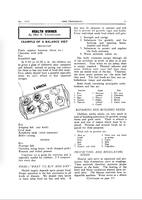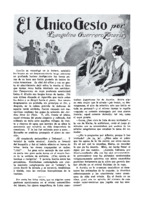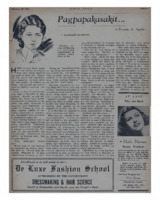Aside from women’s participation in the various women’s magazines, in the 19th century women also wrote articles and were featured in other types of newspapers and magazines. Frequently, we see women writing and being featured in special “Women’s Sections” of popular magazines These Women’s sections usually included articles by and for women on topics such as the home, family, child care, education, fashion, food, and nutrition and health. The sections are sometimes introduced with a separate cover featuring an admired female public figure, such as the wife of a politician. The articles printed in this part of the magazine were not always written by women, and we often come across an article on the woman’s role, purpose or desired behavior, written by men. These would figure as pieces of advice written from the man’s perspective in order to facilitate the woman’s task of being a good wife and companion to her husband.
In other magazines or newspapers, between the more “serious” articles on current affairs or politics, there were other shorter sections, often featuring no more than one article. For example, Good Transmission included sections titled “Better English”, “Health Corner”, “Poetry Column”, and many more that may vary from issue to issue. By briefly examining the different issues available on the repository of the University of the Philippines Diliman, we can observe that the articles in the “Health Corner” are always written by a woman, while the other sections (and most other articles) are written by men. The spaces designated for women in magazines and newspapers portray society’s expectations concerning women. Women journalists were given freedom to research and write about issues related to their own particular private spheres: general health is seen as a part of taking care of the home and the members of the family, including the husband and the children.
Although other sections and topics in journals and magazines were dominated by men, we can also see a trend of women writers rising during the second half of the 19th century and the beginning of the 20th. Because women were being educated at the same level as men, they had the abilities (although not always the possibility) to become writers of novels, short stories, poetry and drama. Literature written in the Philippines was more often than not published first in magazines than in books or collections. Some of the magazines that published literature written in Spanish were La Vanguardia, La Opinión, Excelsior, El Mercantil and El Debate. We can even find some literary works that were never published as such, but which are to be found on the pages of journals and magazines. Some of the women that wrote during this period were Adelina Gurrea Monasterio, María Paz Mendoza Guazón, Nilda Guerrero Barranco and Evangelina Guerrero Zacarías. They wrote text in different genres and various topics: novels, travelogues, poetry; representing the Filipino modern woman and often inserting her in love stories. This trend continued with the emergence of new periodicals in English or in Tagalog.
Bibliographic references
Manlapaz, Edna Zapanta. 2000. “Literature in English by Filipino Women.” Feminist Studies 26(1): 187-200.
Ortuño Casanova, Rocío. “Introducción temática a la Literatura filipina en español”, Literatura filipina en español, Biblioteca Virtual Miguel de Cervantes,
Santiago, Luciano P. R. 2003. “The Flowering Pen: Filipino Women Writers and Publishers during the Spanish Period, 1590-1898, A Preliminary Survey.” Philippine Studies 51(4): 558-98.
Villaescusa Illán, Irene. 2022. “Mujer modeleo y modelos de mujer: el discurso femenino y feminista en la modernidad hispanofilipina.” In El desafío de la modernidad en la literatura hispanofilipina (1885-1935), edited by Rocío Ortuño Casanova and Axel Gasquet. Leiden: Brill.


